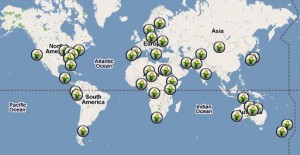- North American Agroforestry; new edition of an old book.
- “Supply will go up, demand will go up, and real prices of grain and oilseeds also will go up” over next 10 years. That’s nice.
- Nescafe coffee goes green in Philippines.
- Rare-breed jamon at $490 a leg. Not so marginal any more.
- Visualizing Tweeter biodiversity observations. Over to you, Luigi.
- Ireland hosts International Potato Genome Sequencing Consortium meeting. Well, obviously.
Evaluation networks redux?
More interesting thinking about the sites of variety yield trials from Glenn Hyman over at AGCommons. You’ll remember he posted a map a few weeks back of the distribution of such sites around Africa, categorized according to which crop evaluation network used them. This is part of a Gates Foundation-funded project to develop an online catalog of these places, including their environmental characterization, and eventually with links to the actual evaluation data they were used to obtain over the years. Glenn then posted about how knowledge of conditions at trial sites could be used to identify the best places for participatory/evolutionary breeding work. And now he’s linked to our recent analysis of interdependence among African countries for plant genetic resources under climate change and suggested that it would be interesting to figure out which sites represent future analogs for current climates: “[w]hat are the key sites for evaluating germplasm in view of climate change throughout Africa?” Is this the MacGuffin we need to get genebanks and breeders to talk to each other more?
Nibbles: Plant bombs, Reindeer and caribou, Livestock wild relatives, Agricultural geography of North Korea, Cyclone rehabilitation, AVRDC, Kew, Organic, Farmers and climate change
- Jacob alerts me that our “throw duplicates of all accessions from an airplane flying across Africa” Gedanken experiment may be closer to realization than we thought.
- Reindeer in trouble. In other news, there are 7 subspecies of the things.
- Indonesia looks to its threatened livestock wild relatives.
- Agriculture (among other things) in North Korea.
- Buffalo distributed in Myanmar. From where?
- Local vegetables promoted in the Philippines.
- More inspirational stuff on the Millennium Seed Bank from Jonathan Drori.
- Organizations Involved in Organic Plant Breeding Projects and Education. Not as many as you’d think.
- “Learning centres” helping farmers identify challenges, adapt to climate change.
Nibbles: Coca to cacao, BXV, Chinese gardening, Forest conservation, Amazon, Soil bacteria, Prairie, Genetics, Wildcats, Milk product
- “No a la droga, si al caucho y al cacao.”
- Spotting banana Xanthomonas wilt (BXW) with biochemical tests.
- The tree that owns itself. Take that, lawyers!
- “The old Chinese gardener in ragged blue coat and trousers with a wispy white beard who potters around smoking one of these long pipes with a tiny bowl — and a mongol cap, periodically performing elaborate grafting techniques on the plum tree.”
- Mexican coffee growers protect surrounding forest. Nepal forest community moving in similar direction?
- Mapping the competition between soy and forest in Brazil.
- Weird agrobiodiversity corner: pseudomonad bacteria help maize take up nutrients.
- Using herbicides to help prairie establishment (including sunflower wild relative).
- Stop press: “Agricultural genetics is one of the easier parts of the solution.”
- “…wildcats preferred resting sites in shelter structures near forest edges.”
- Video on Greek yogurt. Jeremy comments: “I’m going back to Crete.”
The Human Toll of Climate Change mapped
Science Progress has a great interactive map on the effects of climate change on different aspects of human life, including health and agriculture.

Clicking on the pin takes you to the original source of the information. And you can add your own pins. This is just the kind of model that we could use in developing our platform for an early warning system for genetic erosion.